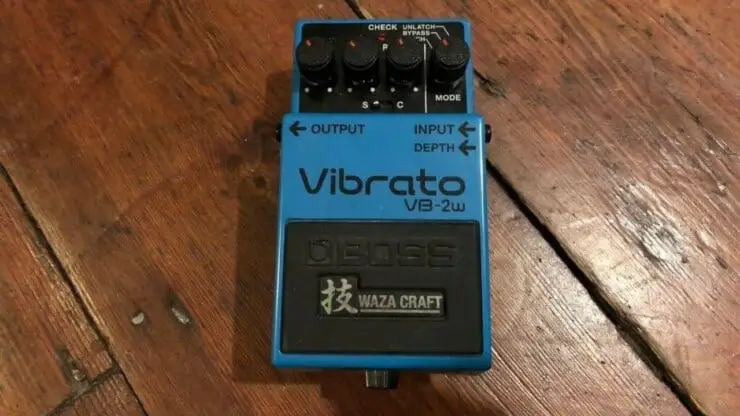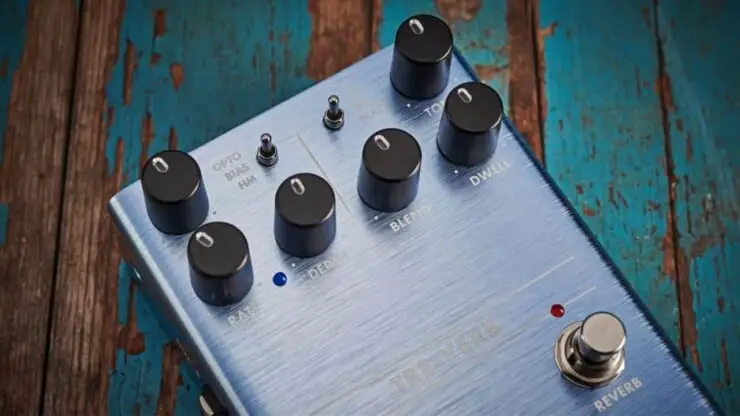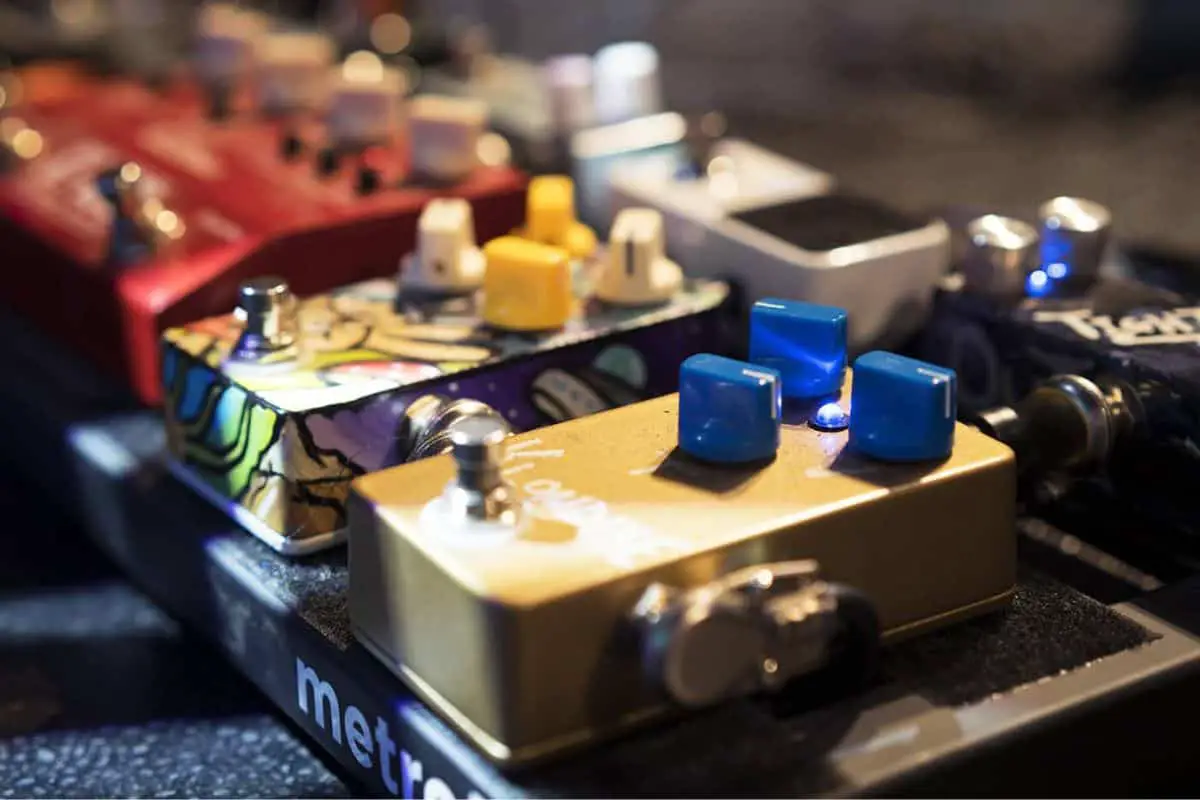Have you been learning to play the guitar and hearing terms like vibrato and vibrato pedal playing around, but don’t know what it is? Don’t worry, here you will get to know all about vibrato pedals.
A vibrato pedal is a stompbox-style effects unit to produce vibrato in the audio signal. Vibrato adds an audible variation in the pitch of the musical note over time. It is normally defined by the depth and speed of the variation.
In this article, you will get to know all about vibrato pedals, how do vibrato pedals work, what does a vibrato pedal do, how to create vibrato with your fingers, and everything else in between. Stick around to get all the answers you’re looking for.
What is vibrato?
Vibrato is essentially a musical effect commonly produced by vocalists and tuned instrument players. The effect will be that of regular pulsating variations in pitch, raising and lowering the pitch of the desired note. Vibrato is used for giving the character and expressions to melody lines. It is largely determined by two factors –
- The amount of depth or pitch variation
- The rate or speed at which the vibrato happens
Vocalists can create it through their larynx control. Meanwhile, guitarists and string players can bend strings or bow the necks of their instruments. Brass and woodwind players can achieve vibrato in many different ways.
Vibrato pedals are stompbox-style units that are designed to receive the guitar, bass, and other instruments. They’ll emulate the vibrato effect by altering the characteristics and expression of the audio signal.
How do vibrato pedals work?
Vibrato pedals work by modulating the frequency content of the audio signal. It’ll then affect the perceived pitch of the signal once it’s transduced into sound. It’s important worth mentioning that vibrato pedals fit into the modulation category of pedals. Although, the audio effects will be pitch-shifting. Most analog vibrato pedals are designed as delay pedals with no feedback loop and no dry signal at the output. Meanwhile, there is a low-frequency oscillator (LFO) for modulating the delay time of the delay circuit.
A vibrato circuit will move away with the delay’s feedback loop such that the delayed signal isn’t repeated. Moreover, there is more to an analog delay pedal. Its bucket-brigade delay chips and signal conditioning circuits will be the talking points.
How will a delay circuit cause vibrato and act to affect pitch? If you’ve previously adjusted the delay time of the activated delay pedal, you would have heard how a delay circuit alters the pitch.
By modulating the delay time of the delay circuit, you’ll be able to alter the perceived pitch of the audio signal. This is similar to a sort of electric Doppler effect. The amount of delay the input signal is experiencing in a vibrato pedal will be modulated through the low-frequency oscillator. This will cause variation in the wavelength and the frequency/harmonic content of the signal.
As the delay time slows, the signal will be effectively time-stretched, which lowers the frequency content and drops its pitch. Meanwhile, as the delay time speeds up, the signal will be effectively time-compressed. This raises its frequency content while increasing the pitch. Think of it as modulating the delay speed back and forth quickly but subtly. This is what the LFO does. Together, this entire system will yield the vibrato effect.
It’s important to note that here, there will be a bit of latency between the input and the output signal. This delay happens as the delay circuit processes the signal. You should remember that the vibrato circuit will be like the modulated delay without the dry signal. By digging deeper, you’ll see that a vibrato circuit is essentially a chorus circuit with a single copy minus the direct output.
Chorus pedal delays will delay the copies of the direct signal and vary the delay times, producing one or more voices with a slight vibrato. The voices will be mixed in with the dry signal at the output. Digital vibrato pedals will emulate the basic design with digital delay and digital signal processing (DSP).
What does a vibrato pedal do?
Generally, vibrato belongs to the modulation effect family. To be more specific, it belongs to the pitch shifter subdivision. Other pitch shifter pedals will include flanger, chorus, and similar. However, vibrato stands out because of how familiar its effect is to an average guitar player. Think of the sound you get when you start playing the tremolo bar on the guitar. This is what vibrato will do to the signal. Speaking of that, you shouldn’t confuse tremolo and vibrato. There is a big difference between the two, you’ll get to know about that later on.

A vibrato pedal will take the input signal from the guitar and shift the pitch of the note you’re playing. This modulation will have multiple dimensions. Not only will you be able to adjust the speed or frequency of the wave, you’ll also be able to adjust how far the pitch will be shifted. For the most part, vibratos are actually the simplest form of pitch-shifting pedals that you’ll find.
A great bit about vibrato pedals is that you’ll be able to change the nature of the modulation. It can be changed in ways that have a subtle or profound impact on the tone. For instance, you’ll be able to create a light whammy bar effect. It’ll barely change the pitch of the tone or go flat out, but definitely get pretty interesting results.
Aside from having the opportunity to adjust the speed and depth of vibrato, some versatile vibrato pedals also allow you to adjust what is known as rise. Rise will determine the amount of time it’ll take for the vibrato to go from the source pitch of the note you’re playing to the full de-tune of the note. This control will alone add an entirely new dimension that you can work with.
Moving on, there are many different modes of operation. The most common ones are Bypass, Latched, and Unlatched. When you’re using the Latched mode, the pedal activates only as long as the foot is pressing the switch. Regardless of how trivial it might sound, this feature is among the most useful features of a vibrato pedal. Meanwhile, unlatched mode is the standard mode where you need to press once for activating the pedal. Then, you should press once again for turning it off.
How to create the vibrato effect with your fingers?
Vibrato involves the subtle alterations in the pitch that you’re playing. The purest way of creating this effect will be with your finger. You would have seen the lead guitarist holding a single note and then moving their fretting fingers to let the note sing. The subtle movement on the fretboard will create a vibrato effect. Stevie Ray Vaughan, Hendrix, and B.B. King were all masters of it.
Guitarists often borrow this fingerboard-based vibrato technique from the strings instrument forebears. If you’re watching the finger of guitarists, violinists, cellists, and bassists, you’ll see the constant motion of their left hand. They’ll be sustaining single notes. They, too, are making use of the vibrato technique.
What are vibrato amps and what effect will they produce?
Beginning in the 60s, instrument manufacturers started adding vibrato effects to guitar amps. The most popular of these was the Fender Twin, which debuted back in 1952. It then added a vibrato channel in 1961. The Fender Vibrasonic that was released in 1959 was yet another vibrato-focused amp. It was priced much higher than the Twin and consequently, it never sold as well. Other popular vibrato amps include the Victoria Amps Reverberato and the Magnatone Panoramic Stereo Amp. These amps come with dials to adjust the intensity and speed of the vibrato.
However, amp-based vibrato usually creates the illusion of pitch modulation and is more or less closer to tremolo. There are numerous stompbox pedals that’ll create more authentic pitch modulation. Some of them include Dunlop M68 Uni-Vibe, TC Electronic TAILSPIN Vibrato, Boss VB-2W Vibrato, JHS Emperor V2 Chorus/Vibrato Pedal, etc. Many high-end vibrato pedals also work as reliable chorus pedals, as the chorus is also a modulation effect. Interestingly, many experts and guitarists consider the amp-based vibrato to come from the Roland Jazz Chorus amp. It makes use of the same circuitry for generating both chorus and vibrato.
Important tips to remember when using a vibrato pedal
Here are some important pointers to remember, as they’ll help you get the most out of your vibrato pedals.
Subtlety is often the best option
Vibrato is one of the effects there, things can get pretty wild very quickly. Unless you’re trying to get cartoonish effects, it’ll be best to keep the settings low. With that said, when you’re in the practice room, you should crank up the knobs to hear what happens. Who knows, you might end up stumbling upon an amazing use for extreme vibrato.
Combining it with Tremolo
Combining vibrato with tremolo adds even more character to the sound by combining both amplitude and pitch. You can try it for yourself with different rates between the two effects.
Emulate the tape warble
You can combine vibrato with any type of Lo-Fi effect, and it’ll help you get awesome effects. You must keep the rate low while adjusting the depth using your ears.
Rise time could be your greatest ally
Natural vibrato is almost impossible to maintain consistently with acoustic instruments, which also include the voice. Although guitarists are accustomed to the electronic vibrato effects, it’ll be beneficial to make the vibrato pedals sound more natural.
Having a rise time helps in achieving it by offsetting the amount of vibrato the pedal is producing as you’re engaging the pedal. This might require clever pedal work. You should use the unlatched mode for getting the most out of this technique.
Vibrato vs. Tremolo: What are the main differences?
In the music industry, vibrato and tremolo are two important guitar effects. However, they’re often confused not just by musicians and guitarists, but by manufacturers too. For instance, many guitarists get labeled with a tremolo arm, when in reality, it’s actually a vibrato arm.
Both tremolo and vibrato modulation effects will produce a similar movement and rhythm sound. This explains why it’s so easily confused by guitarists. The way these two techniques are produced is actually very different.
Vibrato and tremolo are musician notations and modulation effects. They can be used with a wide variety of instruments, both string and wind. You’ll be more likely to hear wind musicians use vibrato. Producing vibrato on wind instruments helps in maintaining consistent tuning in longer notes.
Vibrato
Vibrato is a palpitating sound effect created from small rapid changes in the frequency of a note. It’s an effect that has been used for centuries in musical compositions. In guitars, it is used for adding color and expression to music sound. It will be expressed through two parameters – speed (how quickly the pitch changes) and depth (the amount of change in the pitch).
In other words, vibrato marks the change in the signal of the pitch, making the notes bend up and down. The vibrato effect will give the players a warbly effect, as if the sound will be almost underwater. It’s the thing about having a whammy bar on the guitar, but in the form of a vibrato pedal.
If you’re a guitarist and you aren’t feeling overly confident in your musical notation abilities, a vibrato pedal will be the way to start experimenting with modulation. There are two primary types of vibrato pedals on the market – analog vibrato pedals and digital vibrato pedals. A vibrato pedal will be especially helpful in using if you’re worried about not maintaining a consistent tune or tempo while producing the effect. By using the pedal, all that you need to do is press down and you’ll create the needed vibrato effect.
Tremolo
On the other hand, tremolo is where the musician creates a rapid change in the volume of the note. When researching, you’ll find information and music resources that say that tremolo changes the amplitude of the note. Amplitude will be another word for volume. Essentially, all tremolo does is that it changes the volume or the pitch.
Tremolo modulation can either be produced manually or be created mechanically. Manual vibrato is also known as finger vibrato or hand vibrato. Finger vibrato is a technique where the guitarist uses their fingers/hands to bend the string up and down. This is done by moving the string up and down as the guitarist makes a small alteration in the pitch.

Since the late 1900s, guitars have come equipped, developed, and produced with vibrato systems operated mechanically. They’re commonly found in a hand lever. This is where the real confusion actually starts. The Stratocaster guitar by Leo Fender was released in 1954 and it was produced with the mechanical bridge mechanism. It allowed the guitarists to bend strings from subtle movements to large bends. All of this was possible while keeping accurate intonation.
Tremolo is great for use if you’re looking to create a pulsating effect or other types of percussive effects. If you aren’t very comfortable with manually performing tremolo, tremolo effects are commonly found on stompboxes, amps, and effect devices. If you’re worried about applying the tremolo technique to your music and aren’t able to maintain a consistent tempo or tone, there will be many tremolo pedals. They’ll allow you to produce the tremolo effect by pressing down on the pedal.
These pedals will work very similarly to vibrato pedals but instead of producing vibrato effects, tremolo pedals will produce a wavy, choppy effect. This will depend on the option you’re selecting. When testing and comparing tremolo and vibrato pedals, many feel that tremolo pedals sound more artificial than the vibrato pedal. The effect that tremolo pedals produce is more obvious compared to vibrato pedals that maintain a straight tone.
Conclusion
Thank you for reading. Hopefully, now you know a lot more about vibrato pedals, how do vibrato pedals work, what does a vibrato pedal do, how to create vibrato with your fingers, and everything else in between.
A vibrato pedal is essentially a stompbox-style effects unit that produces vibrato in the audio signal. Vibrato will add an audible variation in the pitch of your musical notes over time. A vibrato pedal will take the input signal from the guitar and shift the pitch of the notes that you’re playing. This modulation will feature multiple dimensions. Not only will you have the ability to adjust the speed and frequency of the wave, you’ll also have the ability to adjust how far the pitch will be shifted.
Image Credit:
Featured Image: Guitar Skill Planet
Images: Boss Area, Music Radar



